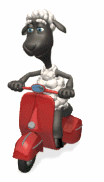![]()

There are around 40 colors and colour varieties in the Icelandic horse strong horse can carry any viking. The name of this mare is Gleði from Höllustöðum
The icelandic horses height ranges between 12.3 (128 cm stick) and 14.3 hands (148 cm stick), with the average horse being 13.2 hands (135 cm stick). It is thought an insult on Iceland to call it a pony, and all over the world they are rightfully called the Icelandic horses. Many a rider has sat on an icy pony for the first time in his life, and returning after the ride saying "This is truly a Horse", such is the feeling of power and personality that glows from the horse.
The Icelandic horse is enormously muscular, and with very dense bones, often with a heavy head and compact body. This breed is possessed of great agility and is also very sure-footed. It carries grown men, even heavy men, at speed without tiring (the heavyweighter in box, George Foreman, rides big Icelandics, as an example).
The Icelandic is economical and easy to keep. Many horses in Iceland are still kept in semi wild conditions, living in pasture all year round, only given hay out on the snow in the worst winter months, sometimes supplemented with salted herring. The average horse eats 15 lb. of grass per day. The youngsters and really pregnant mares might get a handful of grain with a supplement, or salted herring (which is rich of salt and proteins). Often they don't need shoes, if they are only ridden in mud, dirt or sand, but shoeing usually benefits the gaits of Icelandic riding horses. Foaling is also easy, the mares will in most cases just go by themselves and have their babies out in pasture, usually in the morning when you are not watching.
When you are tense, let me teach you to relax.
When you are short tempered, let me teach you to be patient.
When you are short sighted, let me teach you to see.
When you are quick to react, let me teach you to be thoughtful.
When you are angry, let me teach you to be serene.
When you feel superior, let me teach you to be respectful.
When you are self absorbed, let me teach you to think of greater things.
When you are arrogant, let me teach you humility.
When you are lonely, let me be your companion.
When you are tired, let me carry the load.
When you need to learn, let me teach you.
After all, I am your horse.
Willis Lamm.
The icelandic horse has 5 gaits. The gaits are walk, trot and canter/gallop, like in other horses, but also the super smooth tolt and many of the Icelandics also master the 5th gait, the thrilling and fun flying pace.
The tolt is a smooth four beat gait (similar to the running walk or rack) The rider sits virtually bounce free at speeds up to 20 mph. You can carry a glass full of beer or your favorite drink while riding the tolt, without fear of spilling it. The tolt is a natural gait, and you often see foals and grown horses tolting in the pasture.
Many Icelandic horses can also show the flying pace, which is also a natural gait. The pace is a lateral racing gait and horses reach speeds of up to 30 mph.
The Icelandic horse is very friendly and safe to have around you. Kids even
run under some stallions bellies without anything happening. Since there are
no natural predators in Iceland, and the horses have been isolated for so
long, they have virtually no tendency to kick, compared to other breeds. A
majority of Icelandics will never dream of kicking, and those horses that
kick people in Iceland are culled. The Icelandic horse has a very individual
character. The Icelandic horse is patient, adaptable, uncomplicated and sometimes
very spirited. It has a friendly personality and a special affinity for people.
Bred as a riding and working horse for the Icelandic farmer makes it an excellent
family horse. With no natural predators in its home country, the horse has
shed much of its natural "fight or flight" instinct. The easy going,
friendly disposition of many icelandic horses make them ideal family horses.
At the same time, the diversity within the breed is enormous. You can both
find the safest children's horses, and the hottest pace race horses within
this breed, so take care not to think all Icelandic horses are alike.
